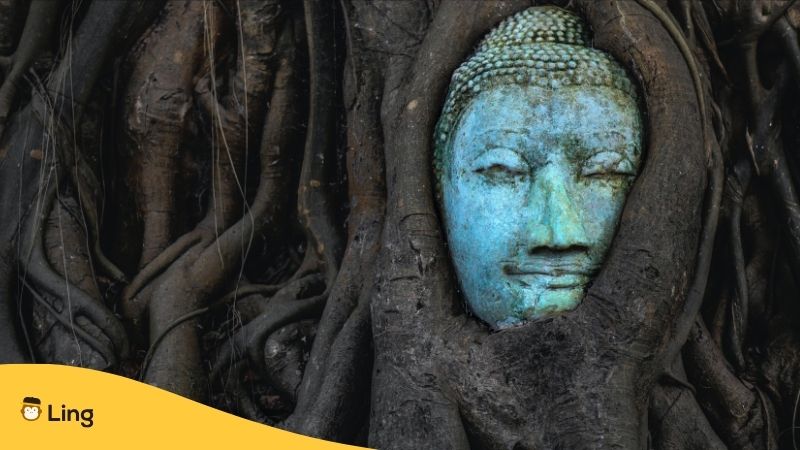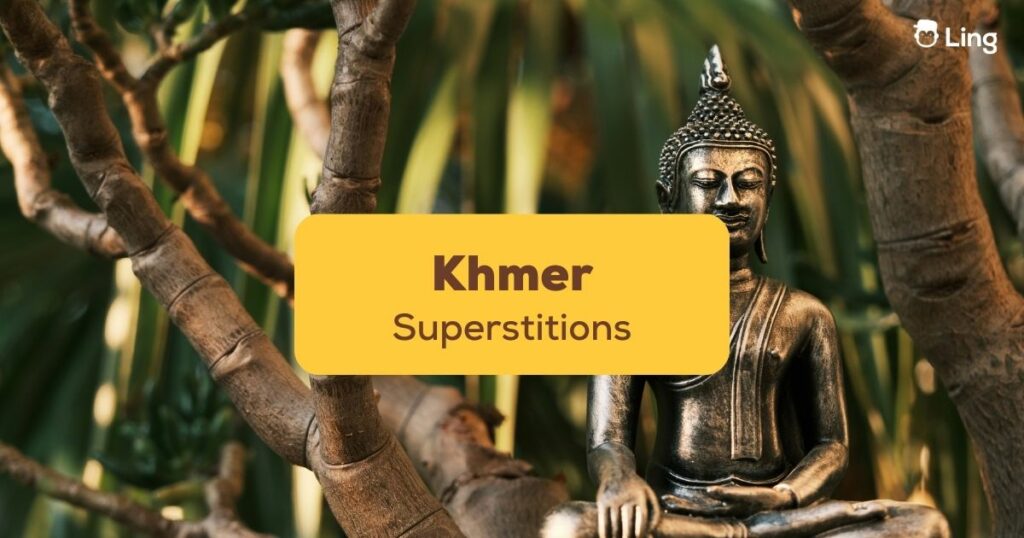One of the most intriguing facets of Cambodian culture is the many Khmer superstitions (a bey chomnue – អបិយជំនឿ) and folk beliefs. These age-old customs provide a peek into the psyche of the Cambodian people, revealing their fears, hopes, and deep desires.
This time, we will be gazing into the intriguing world of Cambodia’s common superstitions, exploring their origins, meanings, and the role they play in the lives of the Cambodian people.
Khmer Superstitions About Birth & Early Life
Khmer: A bey chomnue khmer ampi kamnaet ning chivit dambaung (អបិយជំនឿខ្មែរអំពីកំណើត និងជីវិតដំបូង)
Khmer superstitions kick in even before you are born! Here are a few rituals that take place in order to give children the best start in life.
Protecting Babies From Rahu
If there is a lunar or solar eclipse during a mother’s term of pregnancy, she is advised to rub her belly with limestone in order to shield her unborn baby from the nefarious gaze and deformed face of the evil Rahu. Those who do not, risk giving birth to a baby who has had all the cleverness frightened out of it by Rahu’s wickedness.

Naming Rituals
If you manage to avoid the wrath of Rahu, next up is a naming ritual that holds great significance. Parents often consult with monks or astrologers to determine an auspicious name for their child. It is believed that a carefully chosen name can bring good fortune and protect the child from evil spirits.
Red Threads
Newborns are adorned with red threads around their wrists or ankles to ward off malevolent spirits. The color red is associated with protection and is thought to keep the child safe from harm.
First Haircut Ceremony
When a child reaches its first birthday, the child’s first haircut is performed, and it is believed that this act symbolizes the removal of impurities and negativity from the child’s life.
Daily Life Khmer Superstitions
Khmer: Chivit bracheathngai chomnue khmer (ជីវិតប្រចាំថ្ងៃ ជំនឿខ្មែរ)
Spirits are everywhere in the day-to-day life of the Cambodians, and it is always best to stay on their good side:
Spirit Houses
Many Cambodian households have small spirit houses on their property. These miniature shrines are dedicated to benevolent spirits who are believed to protect the home and its occupants. Offerings of food, incense, and flowers are made regularly to keep the guardian spirit happy.
Spirits In Trees
Cambodians believe that certain trees are inhabited by spirits. They avoid cutting down or harming these trees to avoid angering the spirits and inviting misfortune. The term neak ta (អ្នកតា) is used to refer to the spirit forms that live in the trees, rocks, rivers, and mountains.
Taboos And Omens
Cambodians are highly attuned to the many superstitions, omens, and taboos in everyday life. For example, seeing a black cat crossing one’s path or hearing a dog howl at night is considered bad luck. Conversely, encountering a white snake is seen as a good omen.

Marriage And Love
Khmer: Apa pipea ning snehea (អាពាហ៍ពិពាហ៍និងស្នេហា)
In Cambodia, the number of times a gecko cries out in the night will let you know the current marital state of your future spouse. An odd number and you will end up with a bachelor and an even number, a widower. And it doesn’t stop there.
Marriage Compatibility
Before marriage, many Cambodians consult with astrologers to determine the compatibility of the couple. It is essential to ensure that the stars align, as a mismatch can lead to marital discord and misfortune. Watch out though; if you and a friend smell the same flower, then you are likely to end up sharing your future husband. If you have a dream about a snake, your future spouse is just about to make an appearance in your life.
Wedding Ceremonies
Cambodian weddings are steeped in tradition and superstition. Ceremonies often involve offerings to ancestral spirits and the tying of red strings around the bride and groom’s wrists to symbolize their union and protection from evil spirits.
Illness And Healing
Khmer: Chomngu ning kar pyeabeal (ជំងឺនិងការព្យាបាល)
As in other countries in and around Southeast Asia, superstitions are very important when it comes to staying healthy.
Traditional Medicine
In Cambodia, traditional medicine is still widely practised. Healers, often called Kru Khmer (គ្រូខ្មែរ) meaning “Khmer teachers”, use herbs, incantations, and rituals to treat various illnesses. Superstitions play a significant role in these practices, as it is believed that illnesses can be caused by malevolent spirits or curses.
Spiritual Healing
When medical treatments fail, some Cambodians turn to spiritual healers or monks for assistance. These practitioners perform rituals to exorcise evil spirits and restore balance to the afflicted individual.
Death And Afterlife
Khmer: Kar slab ning chivit banteabbansaam (ការស្លាប់និងជីវិតបន្ទាប់បន្សំ)
Don’t expect being dead to get you out of the world of superstitions as your spirit still needs to properly pass over to the other side.
Funeral Customs
Cambodian funeral customs are a blend of Theravada Buddhism and superstitions. It is believed that the deceased’s spirit lingers for several days after death, so elaborate ceremonies are conducted to guide the soul from its previous life to the afterlife. Mourners offer food, incense, and prayers to aid in this journey.
Taboos And Mourning
Cambodians observe various taboos during mourning periods, such as avoiding the use of scissors or knives in the house. These precautions are taken to prevent the accidental severing of the deceased’s spirit, which would result in unrest for both the deceased and the living people.

Modern Influence And Adaptation
Khmer: Itthipl tomneub ning karosamrob khluon (ឥទ្ធិពលទំនើប និងការសម្របខ្លួន)
In recent years, Cambodia has experienced rapid urbanization and modernization. While traditional superstitions still hold sway with Cambodian villagers in many rural areas, urban Cambodians may be less bound by these beliefs. However, even in cities like Phnom Penh, it is common to see the coexistence of modernity and tradition. Despite the challenges posed by modernization, efforts are being made to preserve and revive Cambodian superstitions and folk beliefs.
Ling: The Perfect Language Tool To Improve Your Khmer
Learning a new language like Khmer can be an intimidating prospect. Ling takes the pressure off by providing you with bite-sized lessons for you to use at your own pace. Give Ling a try today by clicking on Google Play or the App Store.


































































